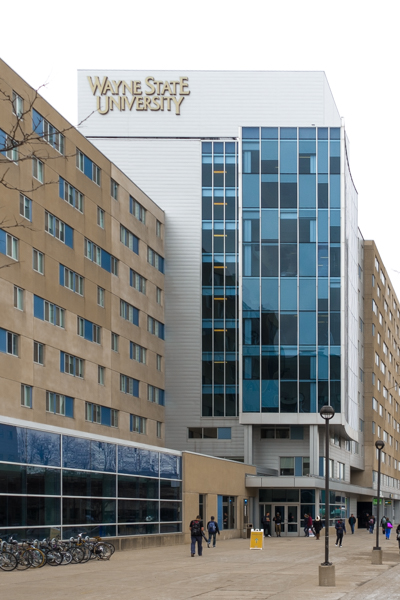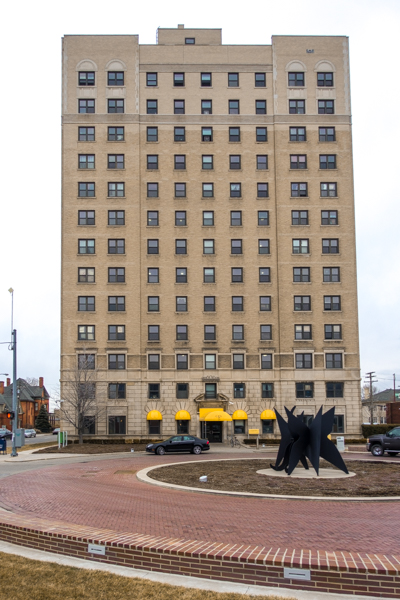Most of the students in this year's freshman class at Wayne State University were just five years old in 2002. While they were attending kindergarten, officials at Wayne State were making what seemed like a big gamble – opening the university's first modern residence hall. They would go on to open a second in 2003 and a third in 2005. 1,800 beds and approximately $100 million later, Wayne State was deeply invested in transforming itself from a commuter school into what it is today, a campus that functions 24 hours a day, seven days a week.
Today's freshman class might have to reckon with it for a minute – certainly the hundreds of those at the back of the waiting list for student housing – but Wayne State's transition was no sure bet. After the three residence halls were built, occupancy was well short of capacity and the idea of a waiting list for student housing seemed overly ambitious. But you can't just build a residence hall and expect it to fill up. To create a 24-hour campus, a university has to provide the amenities that students both want and need. It has to demonstrate that there is good reason to stick around campus.
"The residence halls struggled a bit in the beginning," says Wayne State's associate vice president for business and auxiliary operations and chief housing officer, Timothy Michael, who has been on staff since 2008. "It took some time to get students to think of Wayne as more than a commuter school. We had to build the fitness center and other amenities to make students think of us as more than what we were."
 One of three dormitories Wayne State built in the 2000s
One of three dormitories Wayne State built in the 2000sAs Wayne State invested in making its central campus hum with activity, the residence halls returned the favor, nearing maximum occupancy for the first time in 2008. There has been a waiting list to live on campus for the past three years. The 2015-2016 academic year opened with a 400-person waiting list for apartments and a 150-person waiting list for the residence halls. Demand was so high this past fall that the university rented two floors of the Hotel St. Regis to accommodate the overflow. There is already a tentative agreement to rent three floors the next academic year if necessary.
Wayne State's leadership believed then, as it does now, that providing students with the option to live on campus was critical to the university's ability to grow and attract the best students. While the school does not have a housing requirement, Michael's philosophy is that if a student wants to live on campus, she should be able to live on campus. Today's waiting list and a projected increase in enrollment has the university planning to increase student housing capacity by 800 beds by 2020. 3,147 students lived in Wayne State housing as of September 2015.
This past December, Wayne State completed a 10-year housing facilities master plan that calls for a possible $230 million in development in the form of both new construction and renovations. Wayne State issued a request for proposals in January to build new residence halls with 800 beds' worth of furnished apartment-style housing. The two buildings will be built on Anthony Wayne Drive. The 15-story Deroy Apartments, built in 1972, will be demolished to make way for the new construction. The first new residence hall should provide 400 beds by the fall of 2018.
Wayne State is also close to a deal that would lease a renovated off-campus apartment complex for graduate and professional student housing.
According to Michael, a housing market demand study commissioned in 2010 revealed that while the university was short on-campus beds, the private off-campus market in Midtown could absorb the overflow. By 2014, a second study showed that Midtown could no longer absorb student demand. "What's being built today is not as student-friendly. It's more market-rate prices," says Michael.
One of the reasons student housing is so important to Wayne State is because the Midtown neighborhood in which it resides has seen
an increased demand for housing over the past several years, resulting in occupancy rates exceeding 98 percent and a dearth of housing options with student-friendly rents. The more popular the area gets, the higher the rents climb. It's not unreasonable to posit that at least part of this wave of popularity -- and accompanying higher rents -- can be attributed to the universities in Midtown themselves.
In investing in student housing, the universities introduced a population of young people to a neighborhood with which they may not have otherwise grown so familiar. Certainly for many suburban students, it has served to de-mystify the city, or at least part of the city. Combine that with Wayne State taking part in the Live Midtown program, incentivizing its employees to move to the neighborhood, and the development boom now seems all too predictable. Not that this is a bad thing for Midtown's institutions of higher learning.
College for Creative Studies President Rick Rogers acknowledges that the increased popularity of Midtown has made it more difficult for students to live near CCS. He echoes the sentiment that some students have been pushed out of the rental market and into residence halls. But that's okay by him.
"We see it as a major plus, all this demand for housing in Midtown," says Rogers. "Design students want to live in vibrant neighborhoods and urban areas. Increased density brings increased vibrancy. We feel our location has become a selling point. That wasn't the case five years ago."
 CCS's Art Centre dormitory is currently undergoing renovations to increase its capacity
CCS's Art Centre dormitory is currently undergoing renovations to increase its capacityRogers was hired as president of CCS in 1994. When he took the post, it was a much different place than it is today. There was only one campus, not
two. There was also only one residence hall, the school's first. Purchased in 1987, the Art Centre Building on Kirby still had tenants when CCS students began to move in. They were allowed to stay as long as they wanted, says Rogers, and it was a good experience for all involved. But upon his arrival at the college, just two senior citizen residents still lived in the building, and those who had left weren't being replaced by students. "[The building] was hardly close to full," Rogers remembers. Just 120 of CCS's 760 students, or 15.7 percent of the student body, lived on campus in 1994. Today, however, 580 of its 1,460 students live on campus, or 39.7 percent of the student population. 280 students live in the Art Centre Building and 300 live in the A. Alfred Taubman Center for Design Education. Like Wayne State, there is a waiting list to live in the residence halls.
"Once upon a time, we wondered if we could support student housing," says Rogers. "Now, we're worried that we can't provide enough of it."
CCS is currently renovating the Art Centre Building to increase its capacity by 100 beds. The building also will receive new elevators, a new HVAC system, and newly-configured living quarters that make more efficient use of space. It will stay open throughout the 3-year renovation process. The school is also keeping its eye on the market, looking at how private developments like the M-1 Rail might affect student housing needs.
An emphasis on place
Jeri Stroupe is a senior project administrator in Wayne State's Office of Economic Development, which was created both with the intent to make the university a better neighbor within the Midtown community and to encourage students and faculty to spend more time and money in the neighborhood. The idea is that a more porous border between the university and the surrounding communities, the more all parties will benefit.
Campus amenities like the Wednesday farmers market, which operates June through October and attracts people who live and work in the community in addition to students and faculty members, and the Mort Harris Recreation and Fitness Center, which is free to students and offers memberships to the public at competitive rates, help bring the university and the neighborhood together.
"We don't want to be the ivory tower that sits in the center of Midtown that people go and circle around," says Stroupe. "We want people to come through and be around [campus]."
Through a series of place-based initiatives, Stroupe and Wayne State hope to make the campus an oasis for students and neighbors alike. In response to surveys of students, faculty, and community members, they have placed a renewed emphasis on implementing more outdoor seating options, greenspaces, and other places where people can congregate.
Many of Stroupe's placemaking initiatives are relatively inexpensive to enact. For example, her team has installed signs directing pedestrians to attractions both on and off campus with the goal of making the entire area feel more walkable and bikeable. She characterizes these kinds of projects as low-hanging fruit. "It's important that we find ways to use these spaces and that campus isn't just something you use to pass through from A to B," says Stroupe.
There are bigger projects, of course. In September 2015, Wayne State finished a $27.5-million renovation of its Student Center. Built in 1969 and running thin on its usefulness, the renovations have since re-energized the building. It's drawing students back into the building and giving them a reason to stay engaged with their campus long after their last class has ended, whether it's a place to plug in a laptop and study, meet with one of more than 400 student organizations, or eat at the food court, with its expanded hours serving meals from 7:30 a.m.-2 a.m.
It's an investment, but it's worth it.
"We find that students that stay on campus build community with each other and with the university. They're more involved and connected," says Jeanine Bessette, director of housing and residential life at Wayne State. "Students that are more involved tend to be more successful."
This story is a part of a series of features on the impact of Detroit's anchor institutions. Support for this series is provided by a coalition of organizations, including Henry Ford Health System, Detroit Medical Center, Hudson-Webber Foundation, Wayne State University, College for Creative Studies, and Midtown Detroit Inc.
MJ Galbraith is Model D's development news editor. Follow him on Twitter @mikegalbraith.
Photos by Marvin Shaouni.